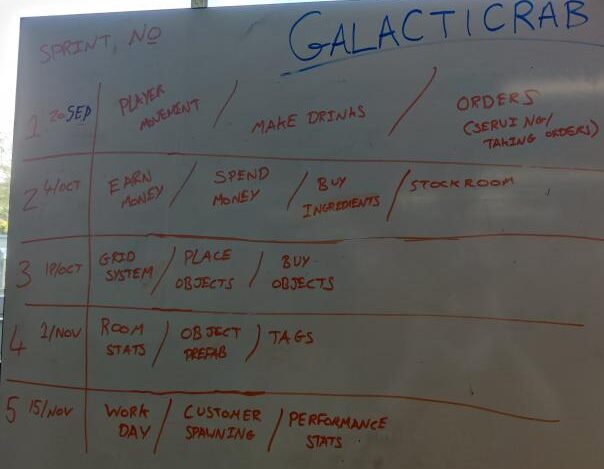Coffee with Cryptids


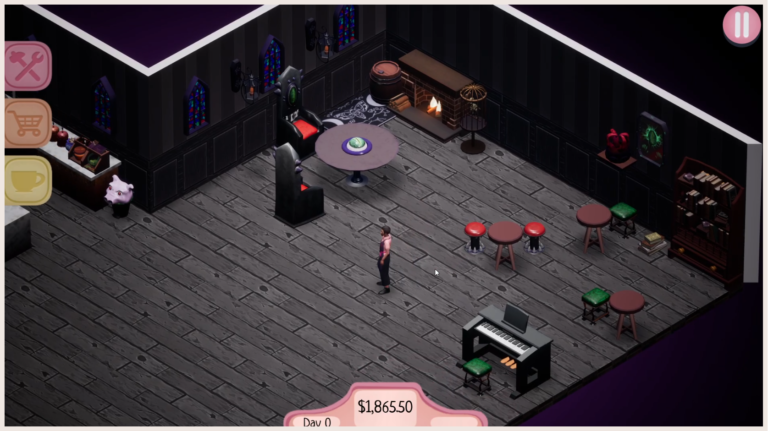
Coffee with Cryptids was developed over 9 months by GalactiCrab Studios. GalactiCrab Studios during this project was a 12 person team consisting of: 3 Designers, 2 Programmers, 5 Artists, 1 Animator and 1 Audio specialist.
The game was created in Unreal Engine 4. The team utilised Agile Development and Git Version Control.
I was a game designer, focusing on Systems Design, Narrative Design and especially Technical Design (Unreal blueprints). I was also a frequent scrum master, producer and leading communicator for the team.
Game Concept
Coffee with Cryptids is an isometric café management game about a café for Cryptids and the recently deceased. The player is tasked with managing each aspect of the café, including everything from designing how the café is decorated to the menu of drinks available to the customers. Each Cryptid has a story to tell, and the player will only get more opportunities to interact with them the more their café suits each of their likes and dislikes.
Earn money by serving drinks to ghosts and Cryptids that visit the café.
Buy furniture to design and decorate the café to suit the players vision and attract desired Cryptids.
Buy ingredients and work stations to expand the drinks menu and please more customers.
Interact with Cryptids to listen to their stories and hear about their day to day lives.
Discover and cater to their likes and dislikes through the design of the café and its menu to induce them to visit the café more often.
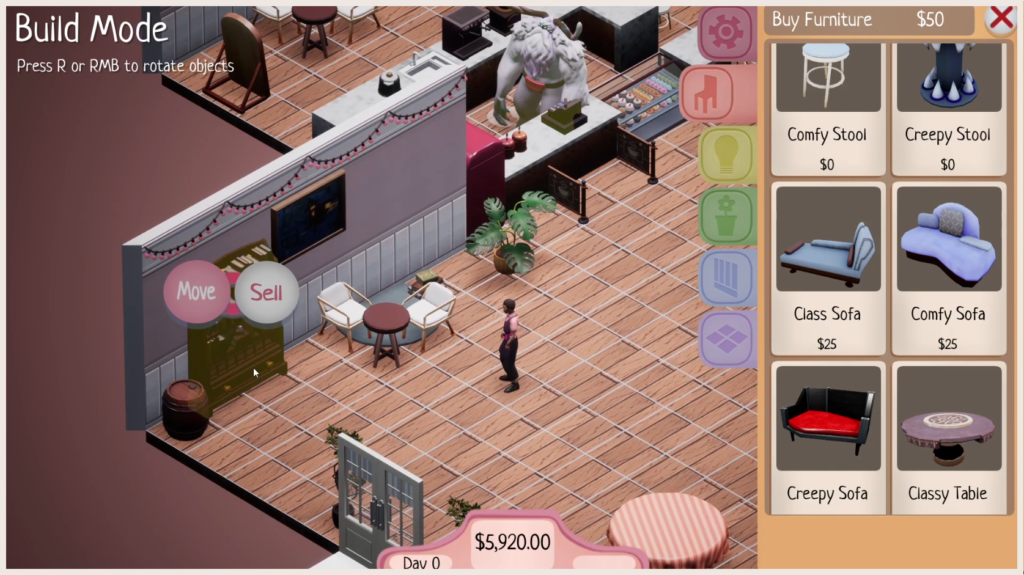
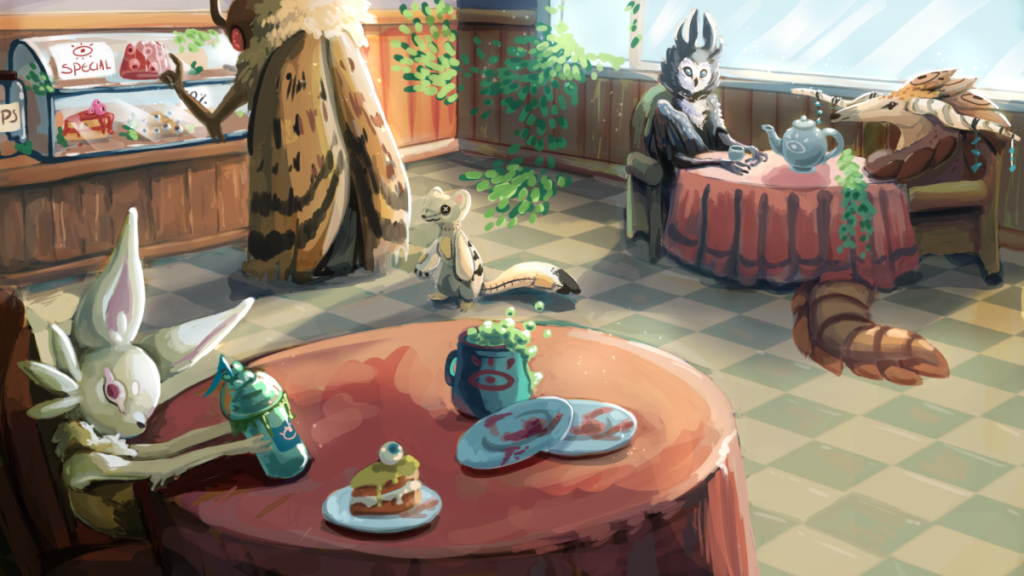
Splash Art by Jesse Hooson
CORE GAME DESIGN PRINCIPLES
Core Game Design Principles
The team really resonated with the idea of a chill atmosphere which offers the opportunity to hear stories and tales from the most mysterious beings in our culture. The game is intended to create an experience which is relaxing and motivates the player through character driven mystery.
The core element to the games design pillars is the level of comfort experienced by the player. There must be no pressure to succeed, plenty of chances for the player to rest and generally just exist. Taking inspiration from games such as Stardew Valley and Animal Crossing, we aim to build gameplay which offers no consequences for playing slowly but also allows rewards for those who wish to optimise their gameplay. Nothing will be taken away from the player if they spend a day in game not doing anything, but things can be gained from using that time effectively.
My Contribution
Narrative Design – Characters
As a key member of the narrative design team, my responsibilities have included: concepting narrative for the characters and the overall game, designing the game systems which communicate this to the player and prototyping those systems in Unreal.
During the pre-production stage of development, myself, Lyra Shillabeer, Zoe Griffin collaborated to discuss and document possible Cryptid characters brainstormed by the team. As a part of these discussions, I would help to create connections between the characters and the gameplay that the team has envisioned. For example, if the player raises the cafe’s illumination statistic (via buying more lights), then that would make Mothman more likely to visit.
I led the production of Cryptid Profiles, essentially character sheets for concepted Cryptids, displaying their characteristics, narrative and how the café statistics affect their chances to visit. These would act as both documentation for the development of the game and as a platform to present our games characters to the games audience or potential investors.
Graphic Design by Lyra Shillabeer. Concept Art – Mix between Jesse Hooson and Adam Bester.
Narrative Design – Dialogue System
Following on from this, I have worked on the games dialogue system. To flesh out the characters, we wanted each character to have multiple stories to talk about. We decided we didn’t want to lay their stories out in a linear narrative from start to finish, that would be too rigid for the open gameplay style we are aiming for. The player will not interact with a character every day, having a single linear narrative could risk the player getting lost or confused if they have not seen that character in a while.
In discussion the team much preferred to have a series of stories which hold low significance, and switch between them depending on environmental circumstances. So instead of a story with a specific plot of events requiring player investment, it would instead be a loosely written series of dialogue related to a certain story or thing that affects the character. This dialogue would still aim to characterise the Cryptids and build bonds with the player, but the perception will be through how they vent and discuss current external events. This also fits into the theming of being a barista of a café talking to your customers.
It is planned that the Cryptids can also have dialogue which will be displayed reacting to player actions. In our game it is already a mechanic that the players actions indirectly attract different customers to the café, it makes sense if the player actions can also affect what characters will say to them. For example, if the player has not installed a sofa, a character which likes sofas might have their dialogue be related to suggesting the installation of a sofa.
The most integral feature of this games story is the emergent narrative experienced by the player. This is why it is left to chance and player decisions to determine which characters will appear and even the dialogue they will say. It is intended for each player to have their own unique cafe with it’s own story. Whilst certain key aspects will be the same, such as the characteristics of the characters or the milestone events that occur, these will always happen in a different order and the cafe design will vary.
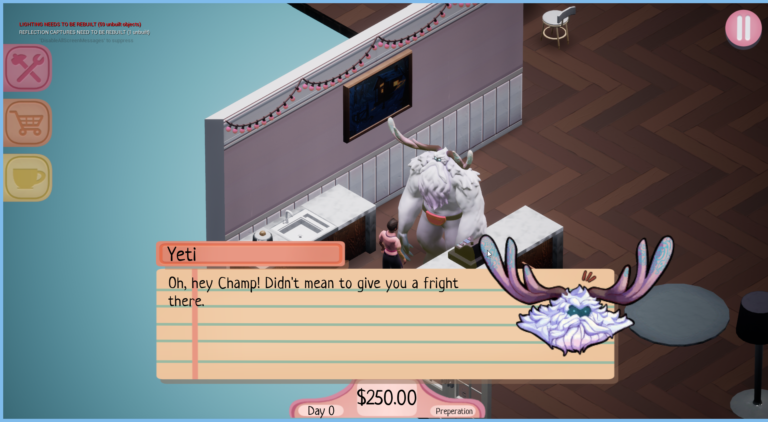
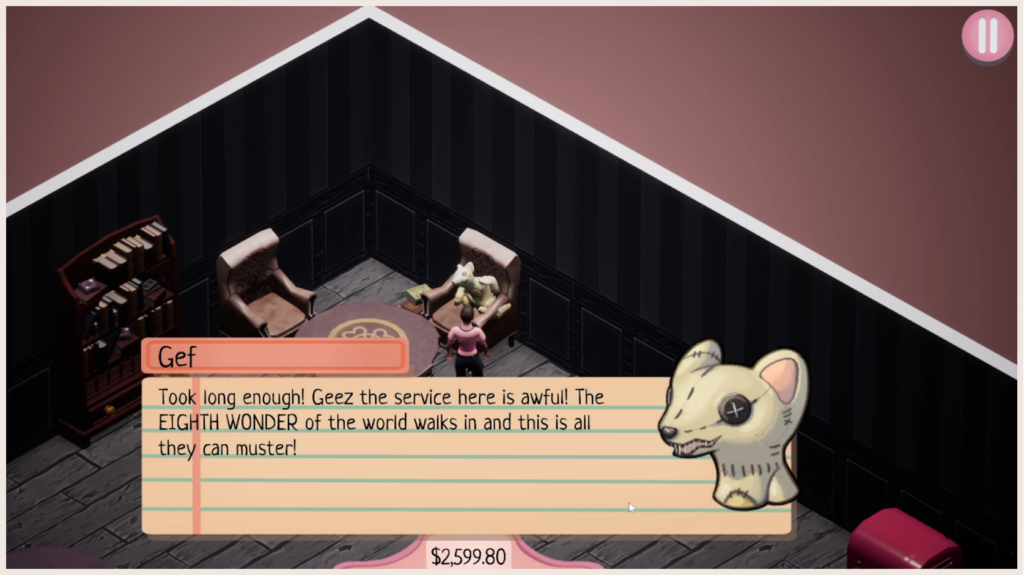

Example of the dialogue system reacting to player actions. After purchasing a creepy wall, Skrap will comment that he likes it.

The first rendition of the blueprint I scripted for the dialogue system.
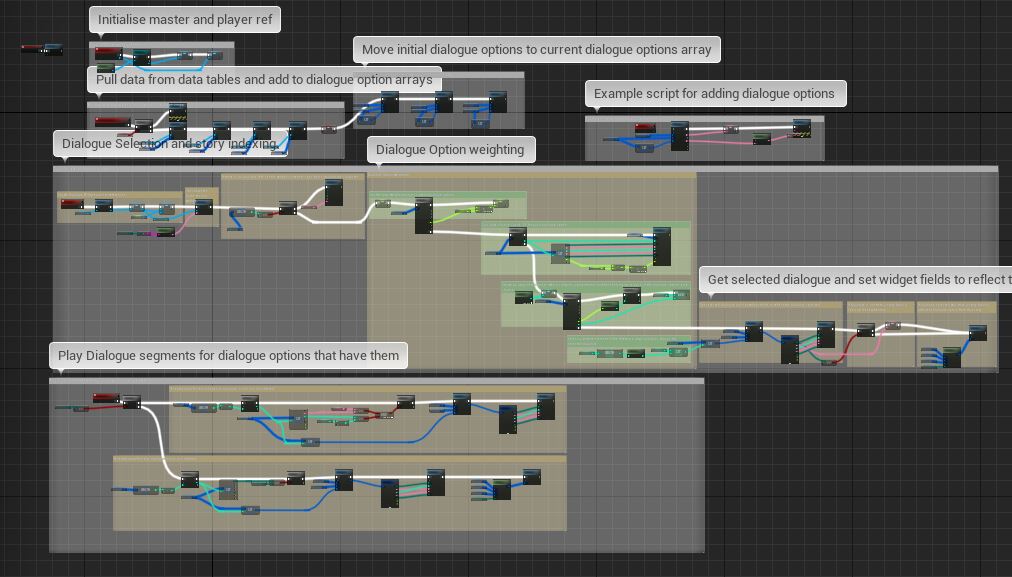
The first rendition of the blueprint I scripted for the dialogue system.
Production
I frequently acted as scrum master, plan and lead meetings for the project and headed the presentation of the game when interacting with tutors and the games’ audience. I play a major role in planning and tracking tasks completed by the team, and contribute to decisions involving direction of the project development and it’s goals.
For this role I consider the importance of gameplay features, and work to break them down into necessary tasks to create them and which resources are required for those tasks (e.g. members of the team and software). I will often communicate between separate specialisms of the team, and bring up discussions where I feel it is necessary. This helps to bring a feature closer to the design envisioned in the game idea.
Through peer feedback I am aware that the team is comfortable and supportive of me in this role. I am keen to learn and develop this role as I feel it is beneficial to me as a game designer. I learn a lot about other specialisms within game development, and the necessities to consider when discussing tasks related to them. I have definitely become more T-shaped since taking up a part time production role on my team for this project.
Prototyping Systems
A large part of my contribution to the team has been as a Technical Designer.Throughout the project I have been learning blueprints and bettered my understanding of game programming. Early on I was responsible for prototyping many of the systems within our game, and as the project has progressed and my skills developed, my responsibility has moved towards programming some of the core features of our game.
As leading narrative designer, the main system I have been responsible for is the dialogue system. Putting my concept into a tangible system in game proved to be one of the most beneficial learning experiences I have had in game development. In its original prototype, I managed to put together a list of functions to express the randomly revolving story element to the characters’ dialogue. This was the first big step in displaying the narrative through gameplay to play testers and tutors at university.
As I became more familiar with the engine and Unreal Blueprints, I further developed the system: I incorporated weighted dialogue selection, allowing a piece of dialogue to be displayed through multiple chat boxes, storing dialogue contents through data tables and CSVs (which are easy to edit alongside Git) and one of the USPs of the game making dialogue which reacts to the players’ actions.
Other systems I have contributed to prototyping and developing include AI, audio implementation, data handling, upgradeable work stations (e.g. coffee machine, fridge) and UI infrastructure. Having this role on the team has greatly increased the scope of my technical skills, I have enjoyed the learning experience it has presented thoroughly.
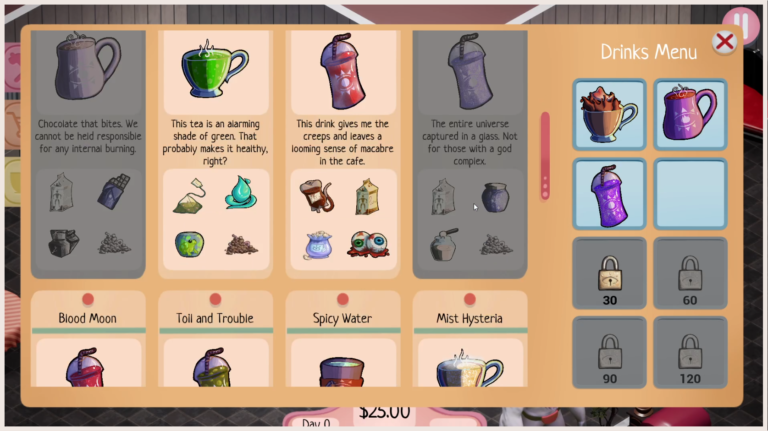
Example of a UI menu which I helped to prototype and program it’s functionality.
